Day 1 of a three day long weekend of Spring Tours today. It was a lovely sunny day, but still with a nagging, chilly and rather blustery NE wind. We met in Wells and headed over to NW Norfolk for the day.
We took a short detour round via Choseley on our way west along the coast road. There were lots of Brown Hares in the fields, and we watched two chasing each other round for some time. After a while a third joined in. It looked like they might start boxing, but they thought better of it at the last minute. One was left to practice on its own, shadowboxing, standing up on its hind legs and throwing some punches in the air.
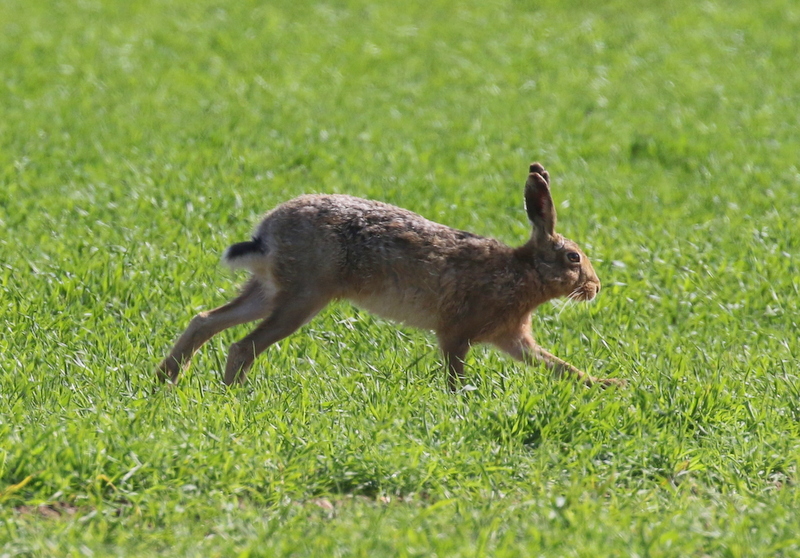 Brown Hare – there were lots in the fields at Choseley
Brown Hare – there were lots in the fields at Choseley
The concrete pad at the barns was quiet when we arrived. A lone Pied Wagtail dropped in. A couple of Swallows and a Sand Martin, the latter presumably on its way somewhere, were hawking for insects around the buildings. We walked onto the start of the footpath and looked out into the field, at which point two smart Yellowhammers flew in and landed on the bare ground just in front of us, which was very helpful of them!
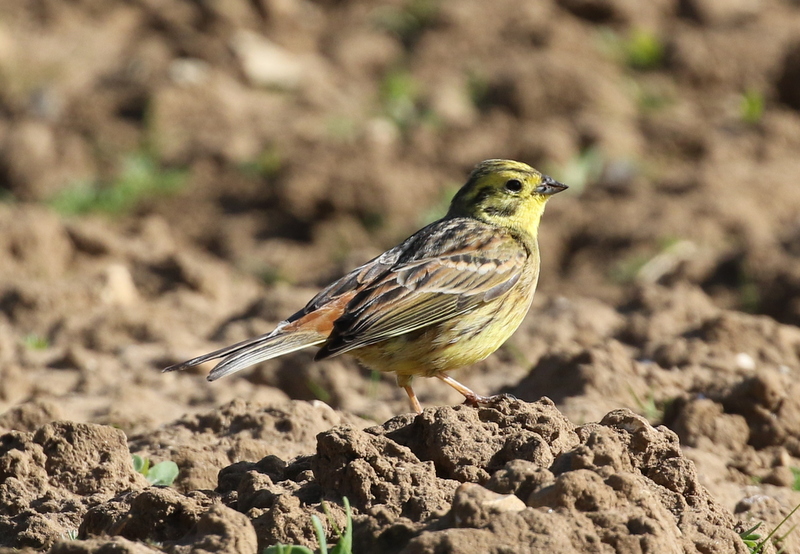 Yellowhammer – two dropped down onto the field in front of us
Yellowhammer – two dropped down onto the field in front of us
There were a couple of Common Whitethroats singing from the hedges but not much else today. It was rather windy up on the ridge. We drove back round via Chalkpit Lane, stopping to look at a Grey Partridge feeding in the entrance to a field. The resident extremely pale Common Buzzard was perched high on a dead branch at the top of a tree.
As we got back down to the main road, we could see a falcon ahead of us, over the church the other side. Through the windscreen, we could see it was a Hobby. It started to drift towards us, and then a second Hobby appeared in the sky with it. First one, then the other, turned and started to power straight towards us, flying at high speed. One passed on either side of the car and they disappeared up the hill behind us.
Our first main destination for the day was Snettisham Coastal Park. As we walked along the path through the bushes, we could hear lots of warblers singing on all sides. A Chiffchaff sang from the wires and a Willow Warbler perched in a hawthorn. A Blackcap was singing deep in the bushes. Sedge Warblers and Common Whitethroats were song flighting, but neither was perching up quite so obligingly as it might do normally, given the wind. A Cetti’s Warbler shouted at us from deep in the undergrowth as we passed and a Reed Warbler sang from deep in the reeds. A Song Thrush added to the chorus.
A Grasshopper Warbler was reeling over towards the inner seawall, so we made our way over to try to see it. We managed to find it, clambering around in a thicket of briars and bare branches, but it was not easy to get onto. It was keeping very low today in the wind. Then it flew across into the hawthorns back along the path. We started to walk back, but some dog walkers were coming the other way and it went quiet.
As we climbed up onto the inner seawall, we could hear a Cuckoo singing. It did one close fly past, looking like a cross between a falcon and a hawk, before disappearing into the bushes further south, where we could still hear it. As we made our way further along, it flew past again, further over, up the middle of the park.
Looking back towards the road, we could see a dove on the wires. It was rather distant and looking into the sun, but through the scope we could see it was a Turtle Dove. Then it flew up in a flurry of wingbeats and circled slowly round and down into the trees – its display flight. A little later it flew up along the edge of the beach, landing in some sallows where we could hear it purring from where we were on the inner seawall.
Common Swifts have been in short supply so far this spring, so it was nice to see three over the park today. They seemed to be enjoying the wind, and zoomed back and forth, coming low over our heads a couple of times.
 Common Swift – three were enjoying the wind over the park today
Common Swift – three were enjoying the wind over the park today
As we got past the bushes and looked out over Ken Hill Marshes, we could see a flock of about twenty geese flying round. They were Pink-footed Geese. When they landed we got them in the scope and could see their dark heads and small dark pink-banded bills, very different from the orange carrot-like bills of the larger Greylags nearby. There were also a few Egyptian Geese out on the marshes and a Marsh Harrier was quartering over the grass.
When the Pink-footed Geese landed, they disturbed a large white bird which landed again nearby. Through the scope we could see it was a Spoonbill. It then promptly tucked its head in and went to sleep, which is, after all, what Spoonbills seem to like doing best! Periodically, when it woke briefly, we could see its distinctive spoon-shaped bill.
As we walked north along the inner seawall, the bushes were alive with Sedge Warblers and several more Reed Warblers sang from the reeds on the edge of the marshes. There were quite a few Reed Buntings too – though the song of the male Reed Bunting is nothing to write home about. We could also hear a couple of Lesser Whitethroats, further over in the bushes.
We cut across to the outer seawall and climbed up to have a look over the Wash. The tide was starting to come in again, but there was still a lot of exposed mud. Along the edge of the water we could see several large flocks of waders, which would whirl round periodically. Through the scope we could see a mix of Bar-tailed Godwit, Grey Plover and Knot, several of which are now coming into summer plumage. The Grey Plovers were looking particularly smart, with their black faces and bellies. There were also a few Dunlin and a lone Turnstone with them.
A Yellow Wagtail flew over calling, heading south, but we couldn’t pick it up looking into the sun. As we started to make our way back, we heard a Tree Pipit call and looked up to see it flying the other way over the seawall. It landed briefly on a briar stem, but took off again before everyone could get a look at it through the scope. A male Stonechat perched more obligingly on the brambles – presumably the female is still on a nest nearby.
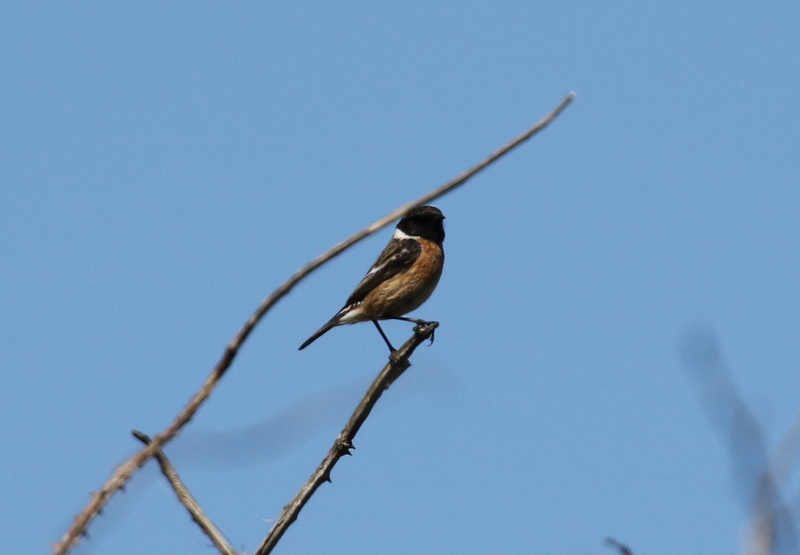 Stonechat – presumably the female is on a nest nearby
Stonechat – presumably the female is on a nest nearby
We could still hear a Lesser Whitethroat singing, closer to us from this side. We made our way through the bushes and saw it zip across into some brambles in front of us. Eventually it appeared on the top briefly.
When we got back to where the Grasshopper Warbler had been reeling earlier, it was still going strong. It was actually back in the same tangle of branches it had been in before. We managed to get the scope on it and everyone had a look, but it was still tucked in tight and partly obscured by branches today.
It was getting on for lunchtime by the time we got back to the car, but we thought we would head round to Titchwell for lunch. A quick stop on the way at Hunstanton produced a few Fulmars over the clifftops. They were mostly keeping down below edge today, presumably out of the wind, but periodically one would circle up in a big arc before disappearing again.
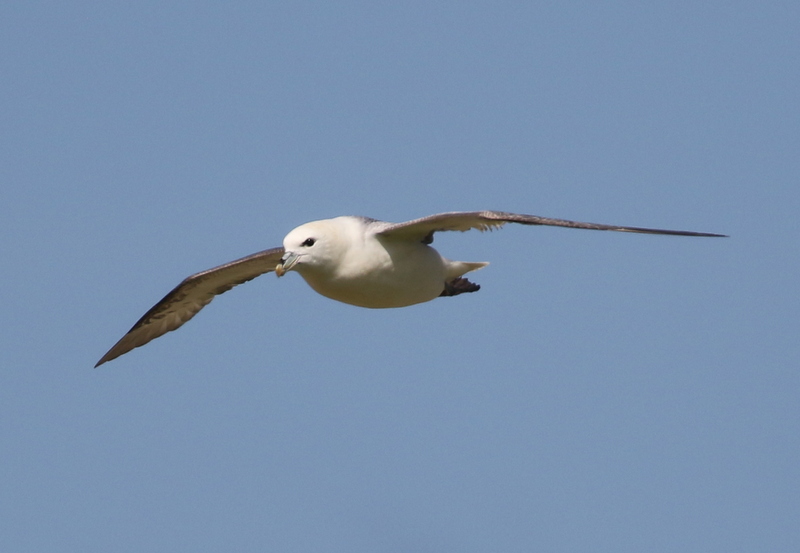 Fulmar – we stopped to admire them flying around the cliffs
Fulmar – we stopped to admire them flying around the cliffs
Over lunch in the picnic area at Titchwell, a Blackcap was singing and perched up for us in a sallow by the path. We could hear Long-tailed Tits calling and watched as a family party of recently fledged juveniles made their way along the edge of the picnic area, begging to their parents as they went. A Goldcrest was flitting around in one of the pine trees too.
After lunch, we made our way over to the visitor centre. There were several Greenfinches on the feeders in front, which are always nice to see these days as the population has declined markedly in recent years due to disease.
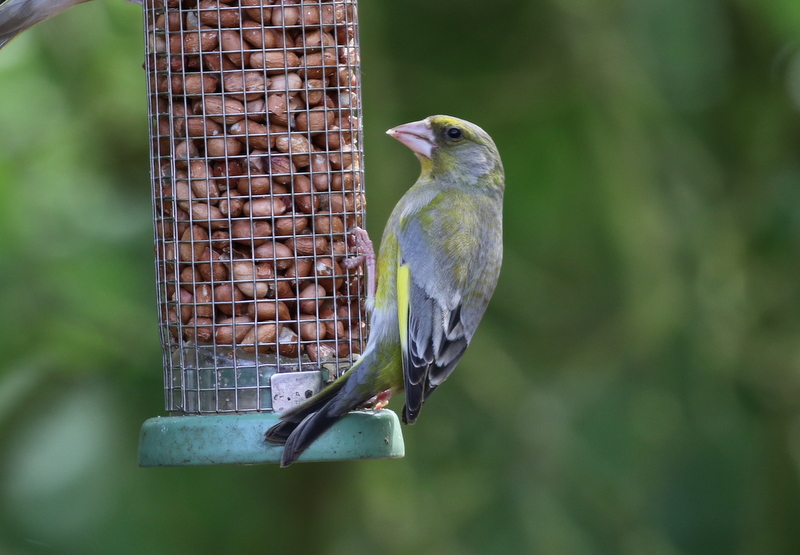 Greenfinch – several were around the feeders
Greenfinch – several were around the feeders
Two Whinchats had been reported today, and as we got out onto the main path we could see one of them on the fence that runs along the edge of the Thornham grazing marsh. It was rather distant at first, but we got the scope onto it. Then the second Whinchat appeared, much closer to us, and the two of them gradually worked their way closer still. When they were perched on dead stems just beyond the fence in front of us, we got some great views. They were both cracking males, with blackish cheeks and a bright white supercilium.
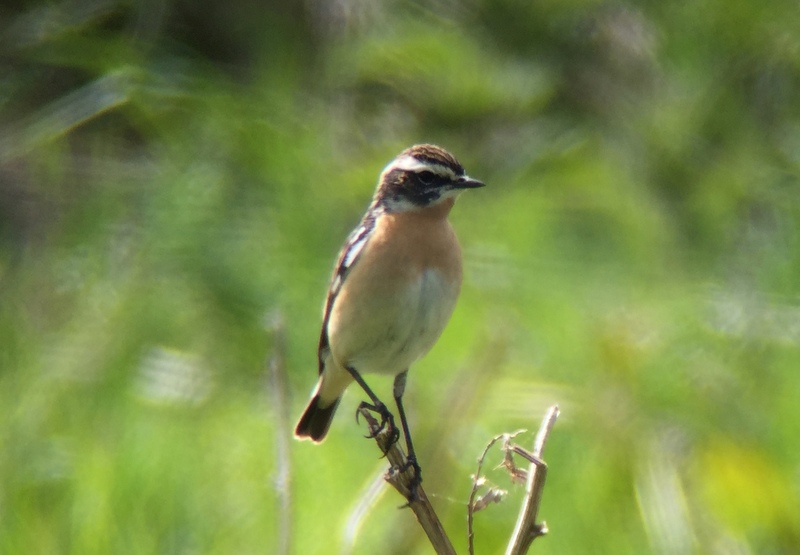 Whinchat – one of two on Thornham grazing marsh today
Whinchat – one of two on Thornham grazing marsh today
The Thornham grazing marsh dried up ‘pool’ was devoid of life again today. Very sad. The reserve side of the path was more interesting, with at least three Marsh Harriers over the reedbed, including a smart grey-winged male. There were a few hirundines hawking for insects including several House Martins, plus a couple more Swifts here too. A quick look at the reedbed pool added a Great Crested Grebe, right at the back, and a couple of pairs of Common Pochard.
It was chilly up on the bank in the wind, so we made for the shelter of Island Hide, from which to scan the freshmarsh. The water level is still high on here, but in spite of that there was a better selection of waders today. As well as the ubiquitous Avocets, there were quite a few Ruff, including a small female Reeve right outside the hide which was probably the bird reported at around that time as a Wood Sandpiper.
 Avocet – there are always plenty on the freshmarsh
Avocet – there are always plenty on the freshmarsh
There were better numbers of godwits today too, mostly Black-tailed Godwits with varying amounts of summer orange. Two Bar-tailed Godwits were asleep on the edge of one of the islands. In with the godwits we found a single Whimbrel, which had obviously dropped in for a bathe and preen. Looking round the few small areas of exposed mud, we found a Common Sandpiper, a Little Ringed Plover and a couple of Turnstones.
The fenced off island intended for the Avocets has been taken over by the gulls. They are mostly Black-headed Gulls but scanning through the hordes, we could just see several Mediterranean Gulls too, deep in the throng. It was nice to see several terns on here today – mostly Common Terns, but a single Little Tern was resting on one of the islands too.
The ducks are enjoying it on here. There were still several pairs of Teal scattered around the edges, which should probably be heading off to their breeding grounds soon, plus several Shoveler and Gadwall. A flock of Brent Geese flew in from the saltmarsh, where they had been feeding, and landed on the water.
 Teal – there are still quite a few on the freshmarsh
Teal – there are still quite a few on the freshmarsh
It was at this point that we received a message to say that there was a Red-breasted Flycatcher just along the coast at Holme. With Wryneck and Redstart reported there too today, we thought it was worth heading round there for the rest of the afternoon. A Grey Heron standing motionless in the reeds by the main path on the way back distracted us for a second.
 Grey Heron – hunting in the reeds by the main path
Grey Heron – hunting in the reeds by the main path
Because we were so close, we got round to Holme very quickly, but when we arrived we found that the bird had disappeared. Even worse, we found out that it had been there for several hours and they had neglected to tell anyone. Not the most helpful! We waited a while to see if the Red-breasted Flycatcher might reappear and checked out the bushes it had been seen in, but there was no sign of it. We decided to go for a walk in the dunes, even though the reserve staff at the visitor centre could not tell us where any of the other birds had been seen. It was rather windy out in the dunes and it was always going to be like looking for a needle in a haystack, with the limited time we had left.
As we walked through the dunes, we did see a Wheatear. It was a female and very flighty in the wind, constantly zooming off ahead of us, flashing its white rear. A Cuckoo was singing from the bushes further down. We could hear a Lesser Whitethroat and found a couple of Blackcaps too. There were several Linnets and Meadow Pipits in the grass. But no sign of any of the other scarce migrants which had been reported earlier. Then it was time to head back to the car and start making our way home.
When we got back to the edge of the pines, we stopped to talk to one of the off-duty wardens. While we were standing there, someone called out nearby that he had found the Red-breasted Flycatcher. It was mostly deep in the pines and very hard to see, flicking across between branches and only landing briefly in view, when it was very hard to get onto. Everyone at least got a glimpse of it, but eventually we were out of time had to call it a day. With a bit of luck, we might be able to have another go tomorrow!
















